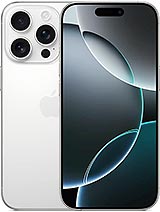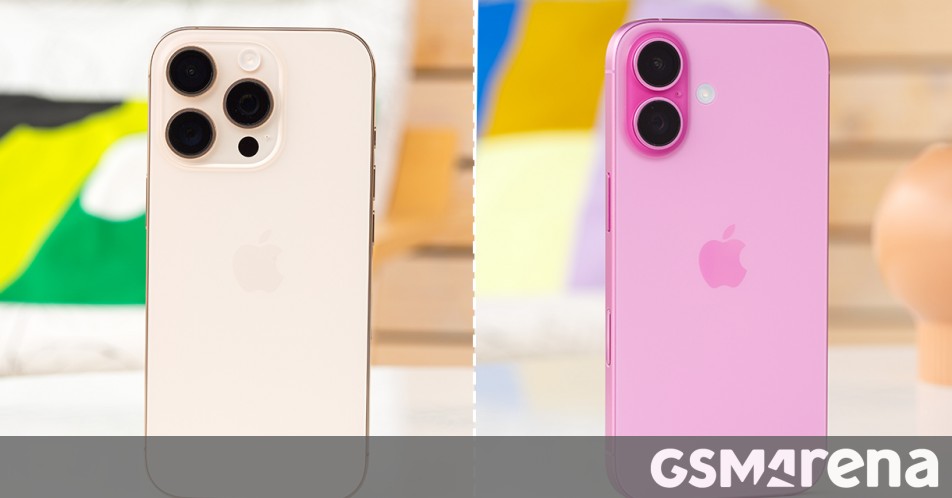The 2024 iPhone lineup poses some of the usual challenges in picking the right model for yourself. One of the more obvious dilemmas, we reckon, is between the vanilla iPhone 16 and the small-size Pro version. Sure, the iPhone 16 Pro is a more capable package, but do you really need all of its Pro-ness and isn’t the plain 16 actually better-suited for some folks thanks to its more pocket-friendly (in more than one way) attributes?
Let’s look into it.
Table of Contents:
For starters, you can compare the complete specs sheets or directly proceed with our editor’s assessment in the text below.
Size comparison
The iPhone 16 takes a major victory in the very first chapter of our comparison – it’s almost 30g lighter than its more esteemed stablemate. While they’re more or less the same size (the Pro is 2mm taller and 0.5mm thicker – almost negligible differences), the two phones differ significantly in their weight and the plain 16 is tangibly lighter and more comfortable to use with one hand. Of course, the 16 Pro feels dense – there’s a sort of a premium impression to its heft packed in a relatively compact body, but the net result is a more relaxing in-hand experience with the iPhone 16 than what you’d get out of the Pro.
The Pro model’s frame is made of a titanium alloy, while the regular 16 uses aluminum. So the Pro just might be better equipped to withstand bumps and knocks. On the other hand, according to the latest data, both apparently use the same third-gen Ceramic Shield on the front, so perhaps scratch and shatter resistance should be on par.
Another thing that both should be equally good at is surviving a dunk in (fresh) water – they are both rated for up to 30 minutes down to 6m underwater.

Display comparison
The weight difference can be at least partially attributed to the iPhone 16’s slightly smaller display – it goes hand in hand with the thicker bezels in what’s more or less the same footprint. The 6.1″ vs. 6.3″ diagonal doesn’t make a significant impact on operation, but there’s another nuance that may be more important – refresh rate. Apple is still keeping the non-Pro models at 60Hz, and we feel like this is unacceptable in 2024, much less at the iPhone 16’s price point. That said, if you’re one who doesn’t see or care about high refresh rate, the 120Hz 16 Pro panel may be wasted on you.
Outside of size, refresh rate and bezels, the two displays are very much on par. They both stand at 460ppi pixel density, with the overall number of pixels determined by the diagonal, and they both will max out at 900nits on the slider and twice that in auto brightness mode. You get HDR10 and Dolby Vision support on both, too.
Battery life
Apple has treated the entire 2024 lineup to a battery capacity increase, with the 16 Pro getting the most significant bump (by 9.4%) to 3,582mAh. The regular 16’s cell got nudged 6.3% to an essentially identical 3,561mAh.
In our testing, we got meaningful improvements in battery life on both phones when comparing with the respective models from the previous generation. That said, the iPhone 16 had an edge over its Pro counterpart in all tests – not a huge difference, but it can add up.
Charging speed
Charging power ratings and speeds are a bit of a gray area in the Apple world, with the official specs stating something to the tune of ‘up to 50% charge in 30 minutes with 20W adapter’ on pretty much all recent models. We tested with beefier chargers and got to the high 50s in 30 minutes on both phones, with a full charge taking roughly 1:40h. The half-hour result is half-decent, but the full charge time is pretty slow. Either way, nothing to split the two models here.
The iPhone 16 and 16 Pro both support wireless charging, maxing out at 15W with generic Qi2 pads, or 25W with proprietary MagSafe pucks (plugged into 30W+ adapters).
Speaker test
Both iPhones feature hybrid stereo speaker setups with one driver on the bottom, and another one up top that also doubles as an earpiece.
Strangely enough, the iPhone 16 was a bit louder in our testing and earned a ‘Very Good’ rating for loudness, next to a simply ‘Good’ iPhone 16 Pro. Both sound rather nice though, so going non-Pro won’t be a downgrade.
Performance
The iPhone 16 features the Apple A18 chipset – a two-gen leap in computing tech compared to the iPhone 15 – it’s a second-gen 3nm chip that is both more powerful and more efficient. The 16 Pro, on the other hand, uses the A18 Pro – also a 3nm chip.
Both SoCs feature six-core CPUs, while GPUs are different even on the surface – 5 cores on the A18, 6 on the A18 Pro. A more in-depth look reveals they not only differ in clock speeds, but also that their designs are rather different, even though both are made by TSMC.
Both models have 8GB of RAM in all versions, while storage starts at 128GB and maxes out at 512GB on the vanilla model or twice that on the Pro.
Benchmark performance
The Pro does have an advantage in benchmarks, but it’s not a huge difference in CPU performance – less than 5% in the GeekBench multi-core test and negligible in the single-core one. The GPU results have a wider margin – to the tune of 14%, but it’s not like the vanilla 16 will be keeping you waiting.

Apple
iPhone 16
AnTuTu 10
1,721,149
Geekbench 6
7,901
3DMark Wild Life Extreme
4,295
Camera comparison
The camera is one of the major differences between the two models and a key deciding factor in this battle – the Pro has an extra camera and a wider-ranging set of capabilities for both photo and video capture.
The plain model will do alright at up to 2x zoom, where the Pro still generally has a minor edge, but from then on, it’s the Pro’s dedicated 5x zoom camera that sees no opposition from the iPhone 16.
You can easily see that discrepancy in the number of cameras on the phones’ backs, but there’s more to it. The vanilla 16 doesn’t have the Pro features, like the JPEG-XL stills format, or 4K120 video capture capability, or the ProRes option.
That said, both the 16 and 16 Pro have the quad-mic spatial audio capture capability, so not everything is a Pro-exclusive.
Similarly, both phones do have the all-new Camera Control, so the vanilla model isn’t handicapped in this respect either – you’ll be able to tweak settings and use it as a shortcut and shutter release just as well on both models.
Image quality
The photos from the main cameras might as well have been taken on the same phone – they’re that similar in terms of dynamic range, color, detail, and overall look. When looking up close, the Pro is a bit grainier – a minor, if inconsequential, win for the 16.




iPhone 16 Pro daylight photo samples, main camera, 1x




iPhone 16 daylight photo samples, main camera, 1x
At 2x, the results are also very similar and if that’s where your zoom pursuits end, the iPhone 16 is as good as the 16 Pro.




iPhone 16 Pro daylight photo samples, main camera, 2x




iPhone 16 daylight photo samples, main camera, 2x
But the thing is, the iPhone 16 Pro has another camera. The 5x telephoto gets you a lot closer to the action, and does so at a nicely high quality too. The iPhone 16 can’t compete at this level.




iPhone 16 Pro daylight photo samples, telephoto camera, 5x
At the other end of the zoom range is where the ultrawide cameras are and here the 16 marks a generational step forward thanks to the added AF capability. The Pro has an upgrade of its own, a 48MP Quad Bayer sensor replacing the conventional one of the old model (the setup that the 16 has been upgraded to), but sensor sizes are the same between the two models.
Image quality is once again a toss-up despite the difference in hardware. If you stare long and hard enough, you might be convinced that the Pro is that little bit sharper and also marginally grainier, but it’s really not an advantage that is an actual advantage.




iPhone 16 Pro daylight photo samples, ultrawide camera, 0.5x




iPhone 16 daylight photo samples, ultrawide camera, 0.5x
The front-facing cameras are the same on the 16 and 16 Pro (also the other 16s and the 15s too, and maybe even the 14s). So you can count on the same selfies from both phones, and they’re some excellent selfies, too.




Selfie samples: iPhone 16 Pro • iPhone 16
After dark, you’d expect some more pronounced differences in the captured photos, with the Pro model’s larger main camera sensor potentially being able to gather more light. In practice, there’s yet more parity. Main camera photos at 1x are essentially the same, and they’re all excellent.




iPhone 16 Pro low-light photo samples, main camera, 1x




iPhone 16 low-light photo samples, main camera, 1x
At 2x, the Pro may have the slightest of advantages in sharpness and detail in some scenes, but it’s not consistent or significant enough to make a real difference – the vanilla model is good enough.




iPhone 16 Pro low-light photo samples, main camera, 2x




iPhone 16 low-light photo samples, main camera, 2x
Once again, we’re at 5x, which is the real differentiator – the iPhone 16 Pro’s telephoto does really well in the dark, and the iPhone 16 better not go there.




iPhone 16 Pro low-light photo samples, telephoto camera, 5x




iPhone 16 Pro low-light photo samples, ultrawide camera, 0.5x




iPhone 16 low-light photo samples, ultrawide camera, 0.5x
Video quality
The iPhone 16 is limited in its video modes, with no 4K120 option (no 4K100 in PAL land either), and no Pro formats. Video quality in the mainstream 4K30 mode is somewhat different between the two, with the vanilla model being noticeably softer at 0.5x and only slightly softer at 1x and 2x. Once again, the Pro’s 5x zoom is a major advantage.




iPhone 16 Pro daylight video samples: 0.5x • 1x • 2x • 5x
At night, there is essentially no difference in video quality – a testament to how good the vanilla model can be. The 1x footage is excellent, the 2x zoom and the ultrawide clips are alright. The Pro’s telephoto struggles at night, but at least it’s there and you could probably find a scene that’s lit well enough to make use of it.



iPhone 16 daylight video samples: 0.5x • 1x • 2x




iPhone 16 Pro low-light video samples: 0.5x • 1x • 2x • 5x



iPhone 16 low-light video samples: 0.5x • 1x • 2x
Verdict
A lot of the info above you could have gathered from the specs, with the rest available in the respective reviews for side-by-side comparisons. Still, we felt the need to have it all in one easily accessible location here – for quick dilemma resolutions.
With that in mind, the iPhone 16 Pro remains the more thoroughly capable package of the pair. It offers a superior high-refresh-rate display in an even more upmarket titanium-clad body. It’s also got a more versatile camera system with a telephoto module and extra software features. The Pro is, then, the better option for those looking to get more creative with the camera.
The iPhone 16, next to the Pro, is a more basic package, that doesn’t go into such camera depths (does still have the Camera Control), and skimps on the high refresh rate. You won’t be sacrificing display brightness, though, and the water resistance is the same at 6m/30min, plus the battery life is possibly somewhat better even. And on top of that, the 16’s main advantages are its lower weight, and the number at the checkout page on Apple.com.

- The larger screen with 120Hz refresh rate and AoD.
- The extra zoom reach of the 5x telephoto camera.
- The Pro options for picture taking and video recording.
- The titanium build.
- The smoothness of the high refresh rate display.
Get the Apple iPhone 16 Pro for:

- The longer battery life.
- The tangibly lower weight.
- The lower price.
- The largely identical user experience.
Get the Apple iPhone 16 for:


